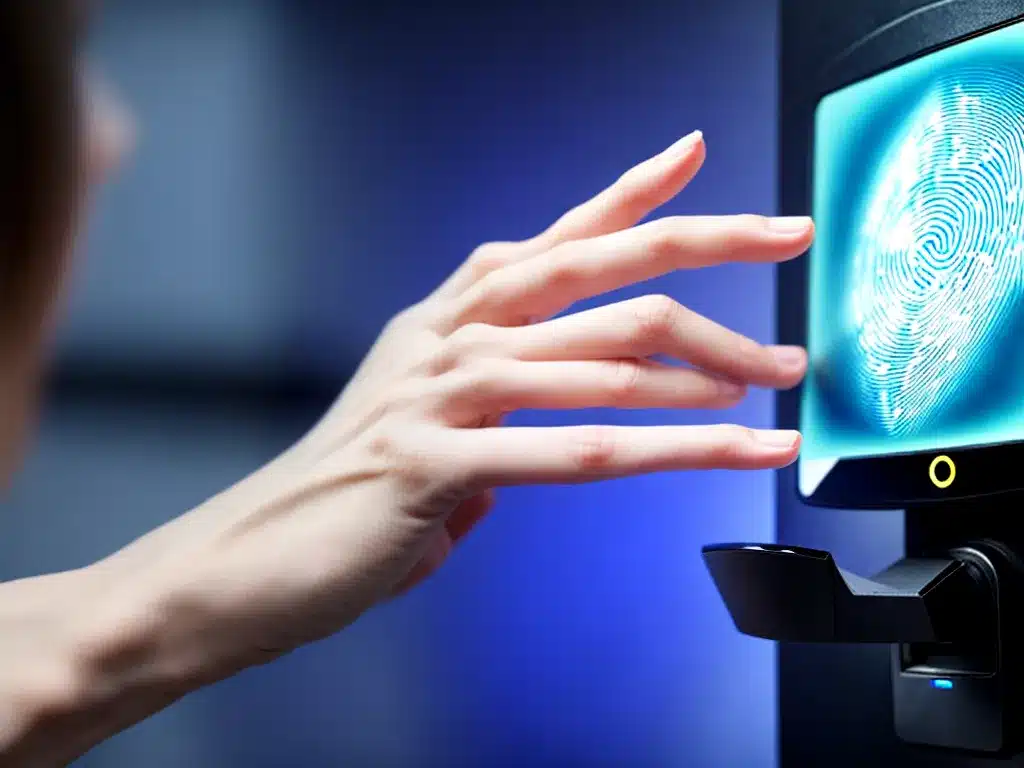
Introduction
Biometric data refers to biological and behavioral characteristics that can be used to verify an individual’s identity. Examples include fingerprints, facial recognition, iris scans, voice recognition, gait analysis and even DNA.
Biometric authentication is becoming increasingly common, with fingerprint scanners on smartphones and facial recognition at airports. Proponents argue biometric data is more secure than passwords or ID cards, which can be stolen or forged. However, as biometric technology expands, important questions arise around privacy, security and ethics.
How Biometric Authentication Works
Biometric authentication uses your unique physical or behavioral traits to verify your identity. Here’s a quick overview of how it works:
-
Enrollment – Your biometric data is captured through a scanner and stored in a database as a digital file. This enrolled data serves as your biometric template for future comparison.
-
Matching – When you need to authenticate, your freshly captured biometric sample is compared to the enrolled template. An algorithm scores how closely they match.
-
Decision – If your live sample and stored template match within a certain threshold, your identity is verified. If not, you are rejected.
So in summary, biometric authentication relies on comparing your current biometric data against a previously stored enrollment template unique to you.
The Convenience vs Privacy Dilemma
On one hand, biometrics offer convenience, eliminating the need to remember passwords or carry ID cards. However, privacy advocates have raised concerns around the collection and storage of biometric data:
-
Mass surveillance – There are fears governments and corporations could use biometrics for mass surveillance and tracking without consent.
-
Data breaches – If biometric databases are hacked, it could result in the theft of people’s unique biometric templates. Unlike passwords, you cannot reset stolen fingerprint or facial recognition data.
-
Function creep – There are concerns that collected biometric data may be used for purposes beyond the original intent, without users’ permission.
How Secure is Your Biometric Data from Hackers?
So how secure is your biometric data? The security of a biometric system depends on several factors:
-
False match rate – This refers to how often the system might incorrectly match an impostor to a legitimate user’s biometric template.
-
Encryption standards – Properly encrypting stored biometric data is essential to prevent hacking. Older systems may rely on outdated standards vulnerable to attacks.
-
Biometric modality – Some modalities like fingerprints tend to be more unique than others such as face scans, impacting false match rates.
-
Liveness detection – Checks like detecting a real finger versus a fake spoof are needed to prevent presentation attacks.
-
Updated algorithms – Algorithm accuracy improves over time. Older biometric systems are more prone to being fooled.
While no method is 100% foolproof, multimodal biometrics combining fingerprint, face and iris recognition can reduce the chances of spoofing. Regularly updating algorithms and encryption standards also improves security.
Biometric Data Privacy Regulations
With biometric data collection increasing, several laws and regulations now exist to protect user privacy:
-
GDPR – The EU’s General Data Protection Regulation has strict requirements for collecting and processing biometric information. Consent must be explicit and data minimization principles followed.
-
BIPA – The Illinois Biometric Information Privacy Act in the US requires informed consent before obtaining biometrics like fingerprints and facial scans.
-
Aadhaar Act – India’s national biometric ID program has specific regulations around data sharing, storage and security. Breaches can incur fines.
Adhering to biometric privacy laws is crucial for organizations handling this sensitive user data. Users should also pay attention to the biometric consent terms when signing up for apps and services to maintain control over their data.
Biometric Authentication: Convenience vs Privacy?
Biometric authentication provides frictionless convenience for unlocking devices and entering secure facilities. However, many people are still uncomfortable with the privacy tradeoffs around collecting and storing unique biometric data, often without full transparency or consent.
Organizations should be transparent about their biometric data practices and provide opt-out choices where possible. As biometric adoption accelerates, lawmakers need to keep pace by enacting strong regulations governing the ethical use of biometrics. Users should also weigh the privacy risks before embracing biometric sign-ins.
Convenience and privacy do not have to be mutually exclusive. With careful implementation, oversight and respect for user rights, biometric authentication can usher in future applications balancing enhanced security with peace of mind.












